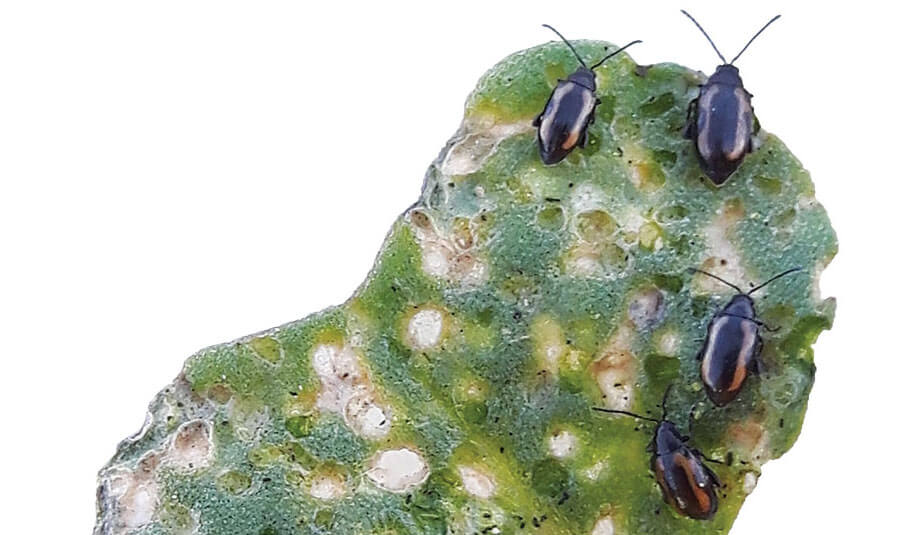Pest number one becomes number one-er
If flea beetles could love, they would love the canola growers who feed them. But the love is not mutual. The Canola Council of Canada (CCC) grower survey of 2020 asked which pests present the greatest economic risk to canola productivity. Flea beetles were number one by a wide margin. The CCC asked the same question in a follow up survey in 2022 and, based on early results, the margin has increased. Flea beetles are pest number one.
One might wonder why these crop gobblers still cause so much grief after decades of canola production and the economic fortitude of 20 million acres a year. The more realistic view is that canola, at 20 million acres, lays out the red carpet for brassica-loving pests. Flea beetles, like mosquitos, mice and my neighbour Fred, will not go away – especially with so much food. They’re here. Stay near. (Be ready for action.) No fear.
Beetle basics
Flea beetles winter in sheltered areas, preferably with lots of foliage, and emerge from late April to early June. All of the flea beetles that show up in canola crops each spring are those that survived the winter. They’re not having a bunch of winter babies. Egg laying occurs in May and June after adults fill up on newly-emerged canola. Larvae hatch and pupate through June and July, around the same time their parents are dying off. The next population of adults break out of their pupae in August. Those are the ones we see in late summer and fall. They feed for a bit then hunker down for the winter.
If those are the same ones that emerge in spring, why not spray them in the fall? A farm could, but it may not be economical. For one thing, winter could wipe out a large percentage of the population without the need to spray. Two, those that emerge in the spring will move in search of food, so spraying one location may not reduce the threat. “They are good fliers,” says Jim Tansey, provincial entomologist for Saskatchewan Ministry of Agriculture. “The distance hasn’t been specifically examined, but there are anecdotal accounts of kilometres-long flights.” Flea beetles drawn in by odours from the first-emerging canola in an area will be motivated to move. Finally, prophylactic spraying – spraying when the economic threat is unknown – is discouraged. So we wait for spring to see what actions, if any, are required.
Striped flea beetles are a little more cold tolerant, so in spring become active one to two weeks earlier than crucifer flea beetles. Early-seed crops, therefore, may have more striped flea beetles.
Like cold-blooded insects in general, flea beetles are most active when weather is warm, dry and calm. Agriculture and Agri-Food Canada research scientist Julie Soroka, now retired, led a study a decade ago on mitigating flea beetle risk. The study found that crucifer flea beetle damage to cotyledons nearly doubled with each 5°C increase in temperature from 5°C to 25°C.
Behaviours change when weather is not warm, not dry and not calm. With high winds, the beetles may move down and feed on stems and the underside of leaves; research is ongoing to verify this. In rainy cool weather, they often take shelter in the soil and don’t feed as much.
Dry weather, as noted, is ideal for flea beetles and, because aridity slows crop growth, it tends to exacerbate the risk. Dry is bad for crops and great for flea beetles.
Vigorous stands
“Flea beetles are rarely a single issue problem,” says CCC agronomy specialist Keith Gabert. Actionable levels of feeding are often related to stand establishment issues. “The combination of low emergence and high flea beetle numbers is dangerous territory.”
Tim Darragh, Bayer market development manager for canola, agrees. “When farmers are having to make four or five applications to save the crop, this is likely a cascade effect resulting from an establishment issue,” he says.
Seeding shallow into warm, moist soil is ideal. If soils are dry, seeding down into moisture may allow for seed germination, but often results in poor emergence and an extended emergence period. With any delays, seed treatment protection may not last through the at-risk period. (Read more on seed treatments in the next section.)
A later seeding date may reduce the flea beetle risk if it means warmer soils and faster growth. Wayne Schneider, who farms south of Edmonton at Nisku, has never sprayed for flea beetles. “It may be because I seed canola one to two weeks later than the earliest seeded canola in my area,” he says.
Curtis Rempel, vice president of crop production and innovation with the CCC, says that in cool spring conditions, it may be more appropriate to seed cereals and pulses first, especially in high-risk areas for flea beetles (See graph 2.). “Seeding canola into dry soil, with low or non-uniform emergence and slow seedling growth leads to a vulnerable crop,” Rempel says. “The reduced yield potential and added cost of foliar insecticide application needs to be balanced off with delayed planting, which could help canola pop out of the ground and grow rapidly.” Like most agronomy decisions, delayed seeding comes with trade offs: it may reduce flea beetle risk but may not be ideal to avoid summer heat on flowers and limit fall frost risk. “Better weather forecasting would help take some of the risk out of this decision for growers,” Rempel adds. “As we get more research on planting date as it relates to flea beetles, that will help improve recommendations.”
Canola plant population is another management factor. In areas where flea beetle risk is high, a target stand at the high end of the recommend range of five to eight plants per square foot will mean more plants for a fixed number of flea beetles. That means fewer beetles per plant, a situation more likely to keep leaf area loss below the threshold of 25 per cent. Of course, more plants mean higher seed costs.
Tillage as a management option is fraught with ambiguity. While canola in warmer blackened soil may emerge faster, that same warm ground cleared of obstacles also tends to attract more flea beetles. John Gavloski, provincial entomologist for Manitoba Agriculture, recalls a situation where volunteer canola growing in wheat stubble had next to no feeding. “Across the road, canola seeded into a bare field was getting hammered,” he says. “Flea beetles, if they have a choice, prefer a more open environment. Stubble can create microenvironment less appealing to flea beetles.” Rempel says some farmers observed lower flea beetle damage on canola growing in corn stubble. “Flea beetles are visual animals and corn stubble may trick the beetle into thinking overwintering habitat instead of food source – even though canola plants are emerging in the field,” Rempel says, adding, “This is hypothetical at this time. More grower data will help us understand the impact of stubble on flea beetle behaviour.” Finally, crop residue retains soil moisture, which can contribute to more rapid emergence when moisture is limiting.
Advanced seed treatment
Julie Soroka’s research from a decade ago showed that neonicotinoid seed treatments provided better control and protection against crucifer flea beetles than against striped flea beetles. Soroka also found that saturated soil and high temperatures during germination and seedling emergence can reduce seed treatment performance.
Rempel says seed treatments don’t work as well or are not actively taken up when the plant is not growing or when moisture is inadequate for the transfer of active ingredient from seed coat to seedling.
In better growing conditions – conditions that allow germination and plant growth to proceed as expected – advanced seed treatments will improve flea beetle protection in high-risk areas.
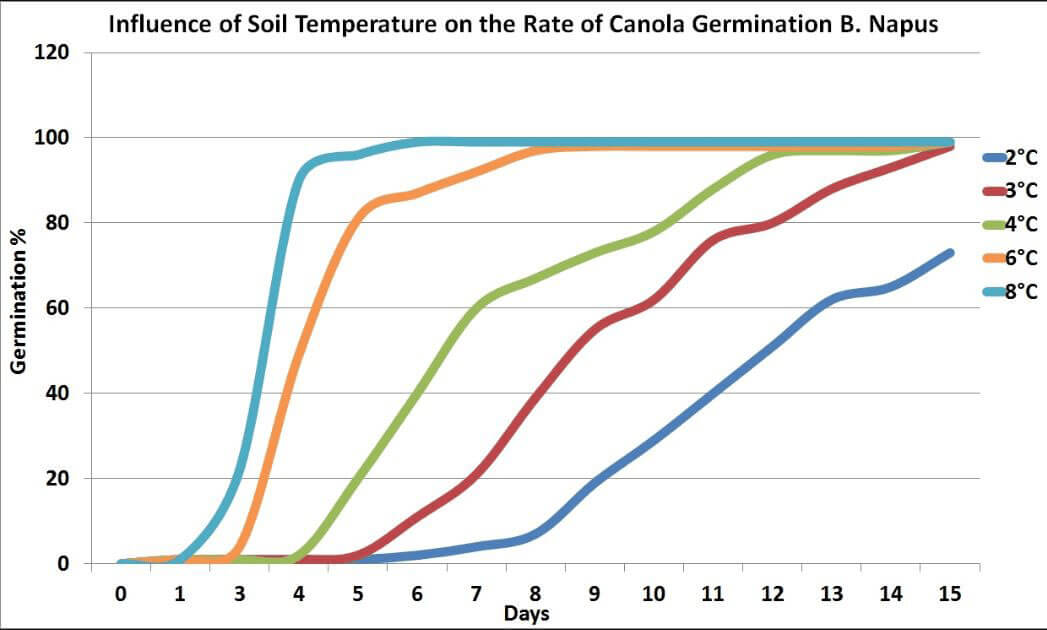
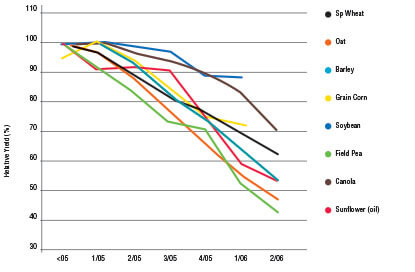
Neonicotinoids are Group 4A insecticides. Advanced products with stronger and longer protection from other active ingredients include Buteo Start, Lumiderm, Fortenza and Fortenza Advanced. (See Table 1 for details.)
Shad Milligan, seedcare technical lead with Syngenta, maker of Helix and Fortenza seed treatments, says treatments are absorbed into the seed and translocated to all plant parts, including stems and the underside of leaves. Flea beetles need to take a bite to take in the insecticide, and a bite anywhere will give them a dose. However, a bite to the stem will be worse for the seedling than a bite to the leaf. This brings us to thresholds.
Aggressive thresholds
The action threshold for flea beetle spraying is when 25 per cent of leaf area, averaged over a few spots in the field, has been eaten and feeding continues.
Insect management thresholds are not rules posted on product labels. They are guidelines to help farmers make input decisions that provide a return on investment. “With canola prices closer to $20 per bushel, not $10, and with plant counts often below five plants per square foot, not the old seven to 14, farms have a lower tolerance for three weeks of feeding stress,” Gabert says.
Rempel says farmers may be in situations where action is required before feeding reaches the threshold. If canola plants are slow growing and lack vigour while flea beetles are numerous and aggressive, the action threshold could be met and surpassed very quickly. “In that situation, growers need to start spraying before 25 per cent, perhaps at 15 per cent,” Rempel says.
Economic spray decisions depend on close scouting during the at risk period. “It is critical to remember that flea beetles can move quickly,” Gabert says. “Warm, dry conditions that promote rapid flea beetle feeding may warrant more aggressive management and daily scouting.”
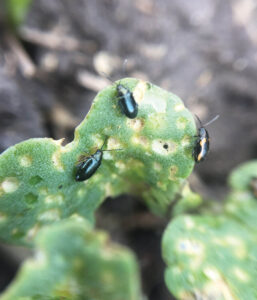 To see if damage is getting worse from one day to the next, flag specific plants. Mark the area with a GPS pin to return to the precise location and use a washer or coloured zip-tie to find the exact plants. Take close-ups of damaged leaves for accurate comparisons each day. “This is so you don’t lose perspective,” says Darragh. “You might think damage is getting worse, but maybe it’s not.”
To see if damage is getting worse from one day to the next, flag specific plants. Mark the area with a GPS pin to return to the precise location and use a washer or coloured zip-tie to find the exact plants. Take close-ups of damaged leaves for accurate comparisons each day. “This is so you don’t lose perspective,” says Darragh. “You might think damage is getting worse, but maybe it’s not.”
And don’t forget to look for stem feeding. Thresholds don’t account for stem feeding specifically, but seedlings with significant bites on the stem may be considered lost. Include them as 100 per cent when calculating average leaf area loss for a field.
If flea beetles overwhelm seed treatments, especially advanced seed treatments, some programs will provide financial support for the required in-crop sprays. But even if in-crop sprays are relatively low cost, farmers want them to work.
More effective sprays
Everything to this point is about strong defence. When flea beetles overwhelm the defences, farmers take offence. With insecticide sprays, precision pays. Fifty shots don’t help much if they all miss the net. And with flea beetles, it can be easy to miss.
Episode 48 of the Canola Watch podcast has Jim Tansey talking about flea beetle behaviours, including how far they can fly to find canola. To listen, go to canolawatch.org and click Podcast in the Quick Links box.
Temperature will affect spray results. Days with temperatures of 15°C to 20°C can provide better results for pyrethroids, the Group 3A insecticides. Research from 1970s showed that pyrethroids were 2.6 times more potent at 15°C than at 32°C. The label for pyrethroid Decis reads: “Do not spray under a strong temperature inversion, or when temperature exceeds 25°C as this will result in a reduction in control.”
With hot weather, spray in the morning or at night, or switch to Group 1B malathion, which has this recommendation: “For best results apply when daytime temperatures are above 20°C.” Sevin XLR, active ingredient carbaryl, is another option. It doesn’t have a specific temperature recommendation but the label says to avoid application with gusty winds or in dead calm.
Cool and wet conditions will reduce product efficacy and will shrink the target – because flea beetles take cover in soil and residue.
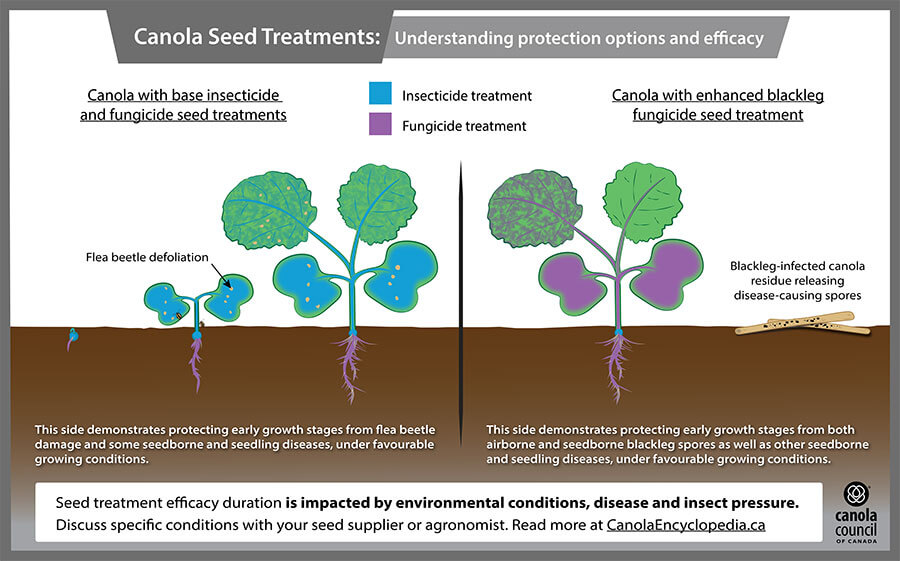
Droplet size also influences insecticide efficacy. For small targets like flea beetles, Tom Wolf, owner of Agrimetrix Research and Training and partner in sprayers101.com, recommends nozzles that produce “medium” droplet sizes. “Any finer isn’t really necessary and just creates drift issues. Coarser droplets risk poor control,” Wolf says.
Low-drift nozzles used for herbicides can create “medium” sprays at higher pressures, but the pressure required for medium sprays may be too high for some nozzles. The easiest solution, Wolf says, is to have a set of finer nozzles on hand, such as conventional flat fan, a pre-orifice design or even certain low-drift venturi nozzles. The finer versions of venturi nozzles will produce a “medium” spray at higher pressures. “Coarser tips for very low-drift uses should be avoided as even higher pressures can’t get the spray quality fine enough. It’s easy to create too fine a spray, and this creates more grief than advantage. Any breeze or hot, dry day will prevent them from reaching the target,” Wolf says.
The “medium” droplet objective can create an efficacy issue when insecticides are tank-mixed with herbicides. Low-drift nozzles recommended for herbicides produce a coarse droplet that may not provide the coverage or contact needed for flea beetles.
Water volume will also improve results. Because insecticides rely on contact as well as ingestion, higher water volumes will improve the chance of droplet contact on beetles and droplet settlement on tiny canola leaves. Randy Retzlaff, technical lead with Syngenta, recommends the label rate of 100 litres per hectare (10 gallons per acre) at a minimum. When striped flea beetles are the more common species, or on a cooler windy day when flea beetles have moved down to feed on stems or the underside of leaves, Retzlaff says results can improve with 150-200 litres per hectare (15 to 20 gallons per acre).
Farms may be able to save some money and time with targeted spraying. If scouting indicates heavy flea pressure along one side of a field, spraying only that area can be enough. However, that strategy usually requires spraying quickly after scouting. Within a day, flea beetles may have spread throughout the field.
Finally, some insecticide sprays have restrictions on the number of applications per field per year. For canola growers anticipating more than one insect pest of concern each season, have a product plan to effectively manage pests and stay within label restrictions.
Table 1. Seed treatments with flea beetle protection
| Trade Name | Insecticide-only Active Ingredient | Group | Chemical Family |
| Prosper Evergol | clothianidin | 4A | neonicotinoids |
| Vercoras | clothianidin | 4A | neonicotinoids |
| Helix Vibrance | thiamethoxam | 4A | neonicotinoids |
| Buteo | flupyradifurone | 4D | neonicotinoids – butenolides |
| Fortenza Advanced | cyantraniliprole+sulfloxaflor | 28+4C | neonicotinoids – butenolides |
| Fortenza | cyantraniliprole | 28 | diamides |
| Lumiderm | cyantraniliprole | 28 | diamides |
Better solutions
“More research is being done so we can give excellent advice to manage flea beetles, and avoid situations where multiple in-crop sprays are required,” Rempel says.
Mária Angélica Ouellette, research coordinator at the North Peace Applied Research Association, has a project to evaluate the effect of canola seeding rate and seed size on flea beetle damage and population. Maya Evenden and Sharavari Kulkarni, crop insect researchers at the University of Alberta, are working on predictive models for flea beetles. Boyd Mori, researcher in agricultural entomology at the University of Alberta, is monitoring flea beetles for insecticide resistance. In the populations he tested, there were no signs of resistance to deltamethrin, the active ingredient in Decis and Poleci. As for resistance to seed treatments, Mori will collect more data through 2023. Alejandro Costamagna, researcher at the University of Manitoba, continues research into the effect of plant density on flea beetle management, the effect of stem feeding damage, the role of natural enemies, and regional predictive models for flea beetle abundance.
Gabert has not heard of any new active ingredients in the pipeline. Commercial launch of an RNA interference product, which would precisely target flea beetles, is not close. A protective hairy canola trait is still in its research phase, and is far from commercial release. Bayer has MagicTrap that could simplify pest insect scouting, including for flea beetles, but they’re still looking at potential applications for North America.
Weather the past few seasons, particularly for the Eastern Prairies, has delayed seedling growth, making plants more vulnerable to flea beetles. Will a change in the weather reduce the risk in 2023? Who knows. For now, farms with two or three bad beetle years are looking at options they can apply immediately – including lower action thresholds, later seeding dates and steps to improve efficacy of insecticide sprays.





